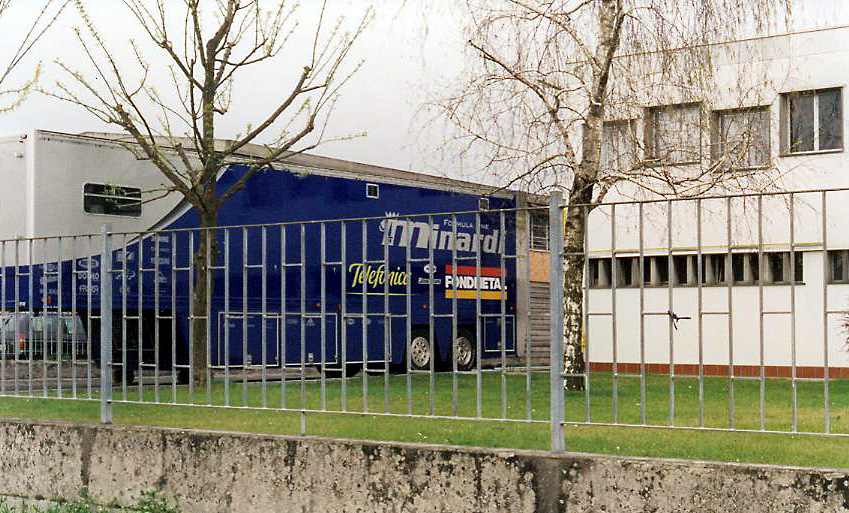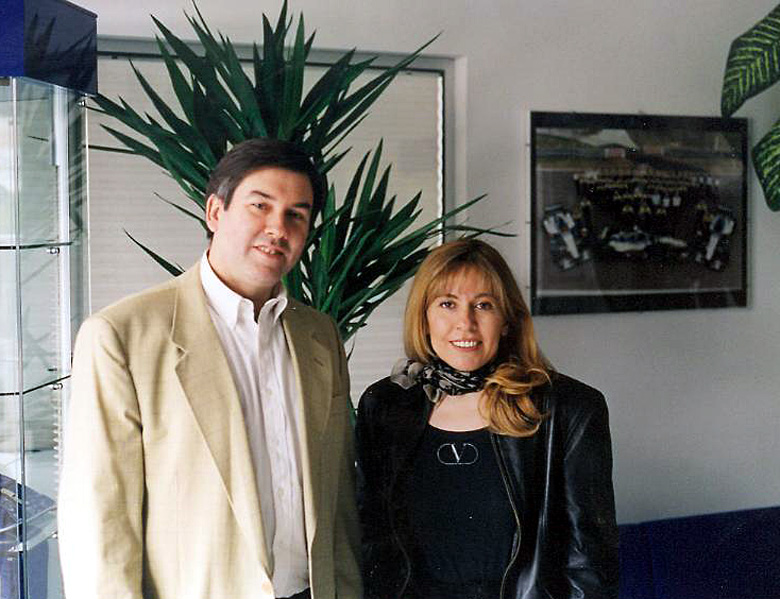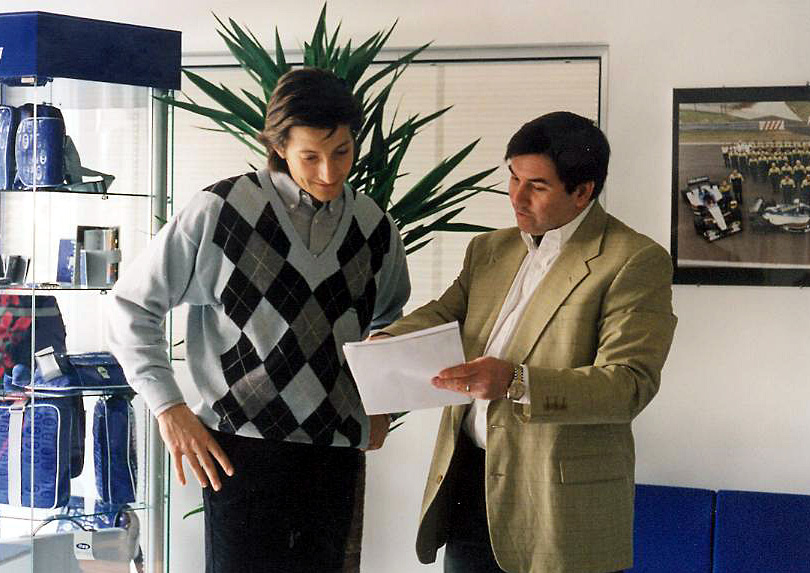By Clyde P. Berryman
Photos by Gulay Berryman
In 2000, we visited the factory of the smallest racing team in Formula One in search of clues to its rugged survivability at the pinnacle of motor sport.
Having fought for an hour to escape from the traffic snarl surrounding Milan that morning, it had been pedal to the metal for the last couple hours to try and stay on pace for an 11 o’clock appointment.I should hasten to add that in this case, “pedal to the metal” was a mere but very vibrating 145 kph in a rather beat-up little hatchback! So the traffic slowdown in front of us caused by endless roadwork in progress just past Bologna was more unwelcome news. Italy’s truck-laden A1 Autostrada is virtually a straight line on the map, heading southeast as it does from Milan toward the Adriatic coast and blowing past such famous cities as Piacenza, Parma, Modena, and Bologna.
The surrounding landscape is as flat as the road is straight, dotted by often abandoned, rustic little “fattoria’s” or stone farmhouse clusters upon which an increasing number of industrial parks are encroaching. Just past Imola, the sky darkened menacingly for a few moments and drops fell. Fifteen minutes later, the gentleman manning the blue tollbooth at the Faenza “uscita” (exit) gave us the last set of directions we would need: “A destra! To the right, then follow the road toward Forli and right again opposite the big BMW dealership.” A few lucky guesses later, we threaded our way through the “Zona Industriale,” and found ourselves only ten minutes behind schedule at our destination: Team Minardi s.p.a.
Mini-Minardi: The smallest F1 Grand Prix racing team but with a World Driving Championship history which now stretches back an amazing fifteen years. A team which, as of the start of the 2000 season, has yet to score a podium finish. A team which has never placed higher than seventh in the Constructor’s Cup and amassed only a total of 28 points in this contest between 1985 and 1999. But yet, a team which could now boast of having participated in an incredible tally of 237 world-championship counting Grand Prix events. By way of perplexing comparisons, that’s more races than either BRM or Cooper and just a handful fewer than Benetton! How have they managed to do it? What keeps the heart of this struggling little outfit beating so courageously in the face of competition bearing names like Ferrari, McLaren, and Williams? At the very least, Minardi would appear to have re-written the manual on how to survive in an age where deep pockets and technology are everything. Is time still on Minardi’s side and if not, when will it run out of options?
A factory visit seemed the right place to start to begin unraveling the mysteries of this team’s psyche. As we approached Minardi’s low white buildings on via Spallanzani, I wondered not only what kind of equipment I would find inside but what kind of people worked here. Happily for me, my good-sport wife volunteered to tag along to take photos which, with her trained artist’s eye, were guaranteed to turn out better than anything I might accidentally produce! She also quickly spotted the discrete “citofono” voice-intercom button as I puzzled over how we were going to penetrate beyond the mobile iron gate guarding Minardi’s parking lot with no one in sight. The small entranceway lobby was all spit and polish. Subdued lighting reflected off modern office fittings. There was an overall impression of glass and chrome with a display case containing Team Minardi signature merchandise. The walls were still painted in the team’s 1999 blue and silver colors. Two attentive pretty faces behind the reception carefully logged our names into the visitor register. Very efficient, I thought.
Good security too, perhaps. Gustav Brunner, Minardi’s silver-haired technical director, made a brief appearance, pausing mid-way down the stairs to check something with the receptionists before vaulting back up past Minardi’s trophy collection, prominently displayed against a wall above the landing.
Moments later, our host Massimo Rivola, who is Minardi’s Marketing Manager, comes sauntering down the same steps to introduce himself and my first pre-conception about the people I would find working at Minardi is put to rest. Why I don’t know, but I had half-expected a middle-aged man, probably a bit overweight, bald or greying – in short, maybe a fast-talking salesman promoted after many loyal years from the sales floor of Giancarlo Minardi’s family Fiat dealership. Instead, I faced a tall, slender young man maybe in his mid-late twenties with fashionable collar-length brown hair, wearing a sleeveless sweater, a friendly engaging smile, and who spoke good English. Massimo exuded obvious enthusiasm and pride in Minardi for whom he had worked for the past two and a half years.
He spoke glowingly about lead driver Marc Gene’s performance at the previous week-end’s Brazilian Grand Prix at Interlagos, the second event of the 2000 season. Gene’s lap times during the race had compared well with those of young British phenom Jenson Button in the Williams, but the latter benefitted from BMW power. At the season opener in Melbourne, a steady drive had brought Gene home to an eighth-place finish and with a fastest race lap within two seconds of that of race winner Michael Schumacher in a Ferrari! “You have to understand only one thing to see why we are so proud of Gene’s times.” Massimo explained. “At every race, we estimate we are at least 100 horse down on the power available to the major teams. So, to turn in laps which are only two seconds off the pace of McLaren, Ferrari…that is really something! It speaks very highly too of the Minardi chassis and that we must be doing the right things to be moving in that direction, to be so close…”
Promising lap times aside, Massimo heaped further praise on Gene: “The team is very happy with Marc. He has a very professional attitude about him. His mental approach toward driving marks him as a potential champion.” If this comes to pass, it will not be the first time that Minardi has provided the jumping off point for a future Grand Prix star. Michele Alboreto, Giancarlo Fisichella, and most recently, Jarno Trulli, all drove for Minardi before moving on to bigger budget teams. Regarding Minardi’s other current driver, new recruit Gaston Mazzacane of Argentina, Massimo pronounced the team “completely satisfied” with results obtained so far. “Mazzacane drove an intelligent race in Brazil in only his second Grand Prix start.” Massimo’s enthusiasm for the team’s pair of young drivers is infectious. Here is a team with a young marketing director who openly bonds on an emotional level in describing the accomplishments and promise of their drivers who are both probably very close in age to himself. Youth is certainly a factor which energizes at least some parts of this team, I thought to myself.
Next: Inside the Minardi factory




Well done!!!
Very interesting article
Thank you for the kind words Roberto! Wait for Part 2 in the next edition when we start getting a peek inside the factory….:))